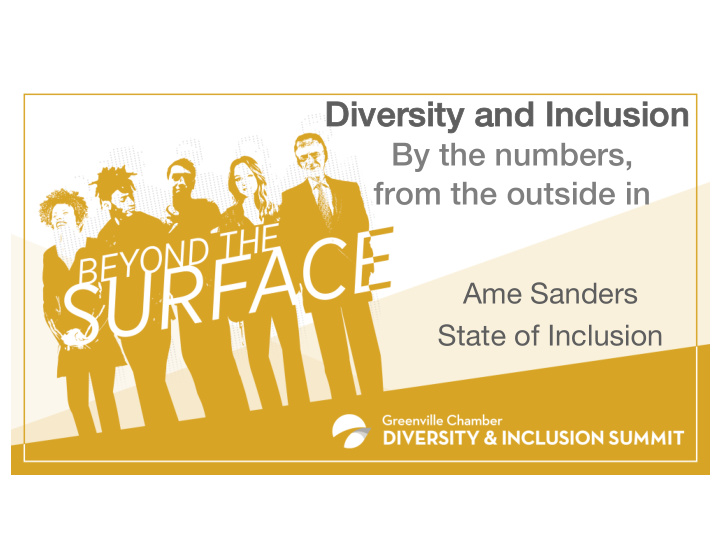



Di Diversity and Inclusion By the numbers, from the outside in Ame Sanders State of Inclusion
Agenda • Intro 5 min • Outside-In Exercise 40 min • Greenville’s State of Inclusion 20 min • Conclusion 3 min • Q&A 7 min
Shared Concept • Diversity is a fact • Inclusion is a choice • Equity is by design
Outside-In Exercise
As we get started… • What we say here, stays here • Ouch and Oops • Self-Care
Outside-In Steps 1. Information 2. Reflection 3. Assessment 4. Engagement Can I find potential benefits and opportunities for my business and the community?
Information – Where to Start? 1. Ways that our community diversity is changing? 2. Broader community choices that demonstrate a lack of inclusion? 3. Systems and institutions in our community that aren’t equitable?
Focus Area Youth that are Disconnected
Youth that are Disconnected % % of youth 16-24 24 not in sch chool or working: Green eenville, e, SC Met etro Area ea 1990 2017* *Average of 2013-2017 Source: American Community Survey (ACS), Public Use Microdata Sample (PUMS) PolicyLink/PERE National Equity Atlas, www.nationalequityatlas.org
Reflection Questions Did you know? Can you relate? Do you personally know any youth considered disconnected? Why do you think this is happening? Why Getting Better?
Assessment – 5 min Impacts for your business or employees? As a business, should you care? If so, why?
Assessment - Debrief Should your business care about this? What are some of the reasons your business should care? (2-3 answers)
Engagement – 5 min Should your business engage on this? Why? Why not? Could there be unintended consequences of engaging? Or not engaging? Who in Greenville is already working on this?
Engagement - Debrief How many feel your business should engage on this? Let’s hear from someone who says no – why not? Let’s hear from someone who says yes – why? Any unintended consequences of engaging, or not? Who in Greenville is already working on this?
Outside-In Recap 1.Information 2.Reflection 3.Assessment 4.Engagement
A Little More About Greenville’s State of Inclusion…
What are some ways that diversity in Greenville is changing?
Growth % % of change in population; Greenville, SC Metro Area 2010-2017 Woods & Poole Economics, Inc., US Census Bureau
Growth % % of change in population; Greenville, SC Metro Area Forecast 2017-2050 Youthful minorities will be the engine to our future growth! Woods & Poole Economics, Inc., US Census Bureau
What are some of the broader community inclusion choices that might be impacting my work or my business?
*Average of 2013-2017 Living Wage Source: American Community Survey (ACS), Public Use Microdata Sample (PUMS) PolicyLink/PERE National Equity Atlas, www.nationalequityatlas.org • Lower earning at every education level, suggests pay equity issues. • In 2015, Greenville Metro economy would have been $3.27 billion larger if there had been no racial gaps in equity.
Are there systems and institutions that don’t work for community equity or my business?
Concentrated Poverty (Poe Mill & Shaw St Area) Tract where > 40% of families in that tract had income in past 12 mo below poverty level. Stratham Place Apts
Living in Poverty % Population Living in Concentrated Poverty Greenville SC Metro 2000 2000 à 2017, 2017, is mor ore e than han 2X 2X incr ncreas ease e in % in % liv livin ing in in c concentra trate ted p poverty rty. 2007 2007-2012, 2012, Greenv eenville e met etro o had had nd fa 2 nd faste test g t gro rowin ing ra rate te o of re f resid identia tial l income s in segre regatio tion o of 1 f 117 m metro tro a are reas in in th the c country try. 1 Source: US Sou S Census Bureau; Ge Geolytics, In , Inc. Policy Link / PE Po PERE Na National Equity At Atlas, www www.nationalequityatlas.org Co Concentrated poverty - if if you liv live in in a census tract where > 40% 40% of fam amilies es in that tract had in in income in in past 12 mo mo bel below po pover erty lev evel el. 2017 2017 repr epres esen ents 5 5 year ear av aver erag age 1 S. S. Reardon on, K. Bi Biscoff, T , The C Continued In Increase o of In Income S Segregation, 2 , 2007-2012, 2012, Stan anford d cepa cepa, h , http:/ ://cepa. cepa.stan anford. d.edu edu/c /content/c /continuing-in increase-in income-se segregation-2007 2007-2012 2012
So What, Now What? 1. Make it your business to know your community 2. Practice outside-in thinking 3.Engage
Want more resources? https://stateofinclusion.com/references-studies/ Want more outside-in conversation? amesanders@stateofinclusion.com
A Few Minutes for Questions…
Recommend
More recommend